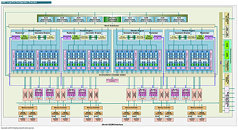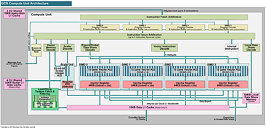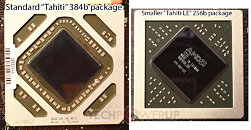Tuesday, September 30th 2014

AMD "Tonga" Silicon Features 384-bit Wide Memory Interface
In what could explain the rather large die-size and transistor-count of AMD's "Tonga" silicon, compared to "Tahiti," it turns out that the silicon features a 384-bit wide GDDR5 memory interface, and not the previously thought of 256-bit wide one. The die is placed on a package with pins for just 256-bit, on the Radeon R9 285, but it can be placed on a bigger package, with more pins, to wire out the full width of the memory bus, in future SKUs. This isn't the first time AMD has done something like this. Its "Tahiti LE" chip was essentially a "Tahiti" die placed on a smaller package with pins for just a 256-bit wide memory bus, on the oddball Radeon HD 7870 XT.
What this means is that AMD's next performance-segment graphics card based on the "Tonga" silicon, could feature 50% more memory bandwidth than the R9 285. The stream processor count is still 2,048, but these are more advanced Graphics CoreNext 1.2 stream processors, compared to first-generation ones on "Tahiti," offering more performance per Watt. The TMU count remains 128, although there's no clarity on the ROP count. Estimates are split between 32 and 48. The R9 285 has 32, and so does "Tahiti."
Source:
PCWatch
What this means is that AMD's next performance-segment graphics card based on the "Tonga" silicon, could feature 50% more memory bandwidth than the R9 285. The stream processor count is still 2,048, but these are more advanced Graphics CoreNext 1.2 stream processors, compared to first-generation ones on "Tahiti," offering more performance per Watt. The TMU count remains 128, although there's no clarity on the ROP count. Estimates are split between 32 and 48. The R9 285 has 32, and so does "Tahiti."



29 Comments on AMD "Tonga" Silicon Features 384-bit Wide Memory Interface
It's sad to say it, but my expectations from an AMD GPU have never been lower.
But you need to try very much hard to defend some piece of AMD's honor:
This is the "weak" dp performance of Maxwell (1/32 of SP performance, a weak one by definition):
Annnnd, THIS is the very much "stronger" performance of the heavenly provide and perfect R9 285:
WTF????
OHHH yeah!
Very much solid performance in DP, Tongo is a weaker chip than Tahiti for GPGPU (no better than R9 280, 3 years later), and a much weaker one with DP than the Maxwell chips. Its a pile of bullshit.
You are speaking nonsense searching some goodness with Tongo.
About next lithography - TSMC does not want 20nm, as they are already preparing 16nm nodes. We will see maxwell on these nodes, as well as whatever AMD is cooking. They better cook good, as good as in 50% performance increase per watt over CGN 1.0 at the same lithography.
Or, they cannot, and they will lose GPUs just like they lost the R9 290 series last week, and will probably lose R9 280X and R9 285 in a few weeks to the medium-sized maxwells
As ErthWen in the post above me pointed out, Tahiti's 1:4 FP64 rate has been cut to 1:16 with Radeon Tonga. IF you assume that Tonga natively (as opposed to AMD's limitation) supports 1:2 rate, then the Tonga based W7100 pretty much just competes with the existing W8100, and the full die will compete with the W9100.
Double precision isn't obligatory for professional cards. FP64 workloads tend to be more the province of HPC than workstation, and AMD's presence in the HPC market isn't great where performance-per-watt becomes an important metric. Even in the WS/HPC single precision arena, AMD face an uphill struggle when the GTX 980 has already demonstrated itself to be a stable 6+ TFlop performer.
Thirdly, while professional boards usually make up the cream of GPU revenue, AMD is basically offering them at very much reduced cost to their largest high profile customer- Apple, so I doubt there is much relief as there could be in that sector.
If you look at the HPC arena, the W9100 has almost a 60% lead in performance/watt vs kelper in DP due to the 1/2 rate DP. AMD is aggressively pursuing that space just from their design perspective. Going from 1/4 DP in Tahiti to 1/2 DP in Hawaii shows that is what they are trying to target. As you see the trend, the more DP performance they try to squeeze out, the less efficient the cards become, same from nvidia's side as well.
Need more proof? Check out the Green500 and theTop500list. Not much in the way of FirePro is there? There is a vast difference between theoretical and actual performance. Meanwhile Maxwell (which you seem to marginalize for esoteric workloads the GM 204 won't be used for) will likely also feature 1:2 FP64 as the GM200, and if it approaches the 96+% efficiency of GM 204 then AMD has its work cut out for it.
If AMD are hinging their future success on double precision workloads, then their driver team really need to start paying attention to their work. Strange that you are now pinning your hopes on FP64 when single precision has been traditionally the stronger aspect of compute for AMD, and that traditional strength is now being taken apart by Maxwell (see the last link).
I expect the 250-300$ market to act the same way. GTX 960 (or Ti) will come in baring a 250-270$ price point. It will outperform the R9 280X and kill the whole market, making AMD think of a proper solution instead of remixing the same architecture again.
My friend got really excited wanting to buy a 285 recently until I showed him better options for far less.
I can't see them offering this it as next-gen like 380X on GDDR, but there's that whole tweet from Robert Hallock the R9 285X graphics product officially doesn’t exist? This is a "Big Reach" perhaps with stacked HBM memory as a "pipe cleaner" . It’s hard to imagine how/what AMD can do within 28nm.
Not sure what can be taken from this yesterday... but it's a/something to read.
www.thinkcomputers.org/amd-to-launch-radeon-r9-380x-in-february/
Then again.... stranger things have happened. There is the remote possibility Nvidia will release a crippled 980ti and have an even bigger part for the 20nm process just to screw with AMD later in 2015.
A 20-25% performance increase is still only slightly faster than the 280X.
AMD in the second half of 2015 on 20nm and HBM will be very interesting to say the least.